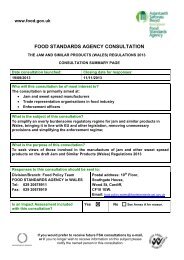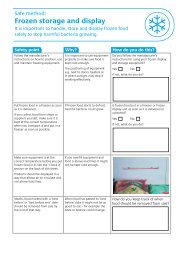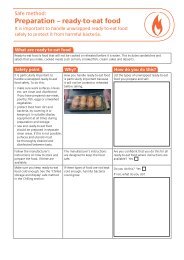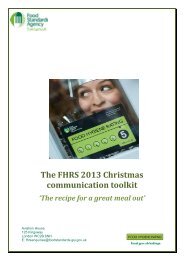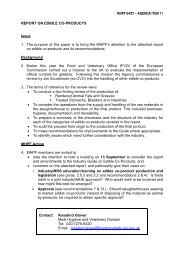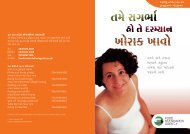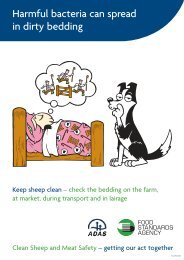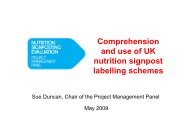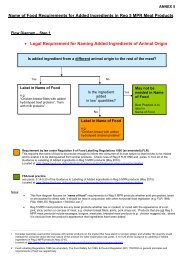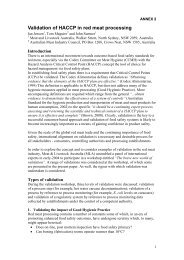6626-03 Your cleaning schedule - Food Standards Agency
6626-03 Your cleaning schedule - Food Standards Agency
6626-03 Your cleaning schedule - Food Standards Agency
Create successful ePaper yourself
Turn your PDF publications into a flip-book with our unique Google optimized e-Paper software.
Safe method:<br />
<strong>Your</strong> <strong>cleaning</strong> <strong>schedule</strong><br />
A <strong>cleaning</strong> <strong>schedule</strong> is a useful tool to help<br />
you clean effectively in your business.<br />
What to do<br />
You can use the <strong>cleaning</strong> <strong>schedule</strong> supplied in the diary to write down how you clean in your business. This safe<br />
method should help you do this.<br />
Alternatively, you may already have a <strong>cleaning</strong> <strong>schedule</strong>. If so, you can continue to use it, but it is a good idea to<br />
look at this safe method and review your <strong>schedule</strong> to make sure that it covers the same things.<br />
It is important to write down how you do your <strong>cleaning</strong>, so you can show what you do. It is also useful for staff<br />
to be able to check how they should clean things, so you may wish to put your <strong>cleaning</strong> <strong>schedule</strong> on the wall.<br />
Safety point<br />
Walk through your premises and<br />
make a list of everything that<br />
needs <strong>cleaning</strong>. This will depend<br />
on what you do in your business.<br />
Some items should be cleaned more<br />
frequently than others and some<br />
should also be disinfected. You do<br />
not need to disinfect everything –<br />
concentrate on those items that will<br />
be touched by food (especially if the<br />
food is unwrapped) and frequently<br />
touched items such as door handles.<br />
You will also need to disinfect<br />
surfaces or items that have been<br />
touched by raw meat, poultry, fish,<br />
eggs and unwashed vegetables.<br />
Or leaks or spills from these.<br />
See the back of this sheet for<br />
information on <strong>cleaning</strong> terms.<br />
For each item, or group of items, write<br />
down what you do on your <strong>cleaning</strong><br />
<strong>schedule</strong>.<br />
Review your <strong>schedule</strong> regularly and<br />
check that all the <strong>cleaning</strong> is being<br />
done properly.<br />
How do you do this?<br />
You may find it helpful to go through the following examples:<br />
Items that need <strong>cleaning</strong><br />
• Checkouts/cash registers<br />
• Counter tops<br />
• Shelving<br />
• Floors, walls, ceilings<br />
• Chilled and frozen storage and display equipment (which may need<br />
defrosting)<br />
• Storage areas<br />
• Waste areas and drains<br />
• Staff areas including toilets<br />
• Sinks and soap dispensers<br />
• Equipment with moving parts e.g. coffee machines<br />
Items that need <strong>cleaning</strong> and disinfecting<br />
Items that come into contact with food<br />
• Work surfaces<br />
• Re-usable cloths<br />
• <strong>Food</strong> display trays<br />
• Equipment e.g. serving tongs, soft ice-cream machines<br />
Frequently touched items<br />
• Rubbish bins, broom and mop handles<br />
• Door handles, taps, scales, switches and controls<br />
• Telephones<br />
Include details on:<br />
• How you clean the item(s)<br />
• What chemicals you use and how to use them<br />
• What equipment you use<br />
• How often you clean the item(s)<br />
Train staff on the <strong>cleaning</strong> <strong>schedule</strong>, so they know what they have to do,<br />
and when. Supervise <strong>cleaning</strong>.
Example of a <strong>cleaning</strong> <strong>schedule</strong><br />
Item<br />
Floors<br />
Chilled<br />
storage<br />
Dry goods<br />
shelving<br />
Work<br />
surface<br />
Cleaning terms<br />
Frequency of <strong>cleaning</strong><br />
After use<br />
Safety<br />
precautions,<br />
e.g. wear gloves<br />
or goggles<br />
Wear gloves<br />
Wear gloves<br />
EXAMPLE<br />
X<br />
Daily<br />
X<br />
Weekly<br />
X<br />
Monthly<br />
X<br />
Other – specify<br />
Wear gloves<br />
Detergent<br />
A chemical (e.g. washing-up liquid) used to remove grease, dirt<br />
and food. Used for general <strong>cleaning</strong>.<br />
Disinfectant<br />
A chemical which kills bacteria. Check that surfaces are clean<br />
of grease, dirt and food before you use a disinfectant.<br />
Sanitiser<br />
A two-in-one product that acts as a detergent and a<br />
disinfectant. If you use a sanitiser, make sure you use it first to<br />
clean and remove grease and then again to disinfect. Always<br />
follow the manufacturer’s instructions.<br />
BS EN standards<br />
Disinfectants and sanitisers should meet either BS EN<br />
1276:1997, BS EN 13697:2001 or BS EN 1276:2009 standards.<br />
Method of <strong>cleaning</strong><br />
1. Sweep the floor, including under equipment, to<br />
remove any obvious dirt.<br />
2. Wash the floor thoroughly using a mop and bucket<br />
and hot soapy water (detergent diluted according<br />
to manufacturer’s instructions).<br />
1. Remove products.<br />
2. Clean surface using hot soapy water (detergent<br />
diluted according to manufacturer’s instructions).<br />
3. Rinse with clean water.<br />
4. Dry with a clean cloth, ideally a disposable one.<br />
5. Put products back – put those with the closest<br />
‘use by’ dates at the front.<br />
1. Remove products.<br />
2. Clean surface using hot soapy water (detergent<br />
diluted according to manufacturer’s instructions).<br />
3. Rinse with clean water.<br />
4. Dry with a clean cloth, ideally a disposable one.<br />
5. Put products back – put those with the closest<br />
‘best before’ dates at the front.<br />
1. Remove any obvious food and dirt.<br />
2. Wash the surface with hot soapy water (detergent<br />
diluted according to manufacturer’s instructions)<br />
to remove grease and any other food and dirt.<br />
3. Rinse with clean water to remove the detergent<br />
and loosened food and dirt.<br />
4. Apply a disinfectant. Make sure you leave it on for<br />
the contact time recommended by the manufacturer.<br />
5. Rinse with clean water to remove the disinfectant.<br />
6. Leave to dry naturally or use a clean disposable cloth.<br />
Dilution rate<br />
Most <strong>cleaning</strong> chemicals are concentrated, so you need to<br />
add water to dilute them before they can be used. It is<br />
important to follow the manufacturer’s instructions on how<br />
much water to use with the chemical. This is the ‘dilution<br />
rate’. If you add too much or too little water, then the<br />
<strong>cleaning</strong> chemical might not work effectively.<br />
Contact time<br />
This is how long a <strong>cleaning</strong> chemical needs to be left on<br />
the item you are <strong>cleaning</strong>. It is important to follow the<br />
manufacturer’s instructions on contact time for the<br />
chemical to work effectively.<br />
RCL5/09-12



